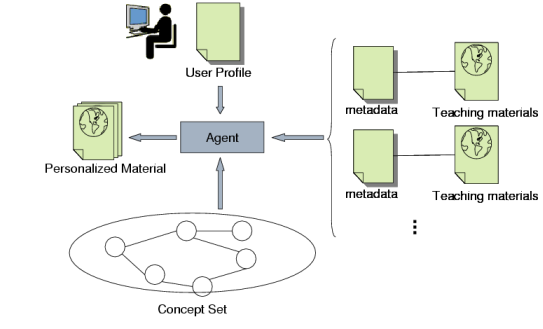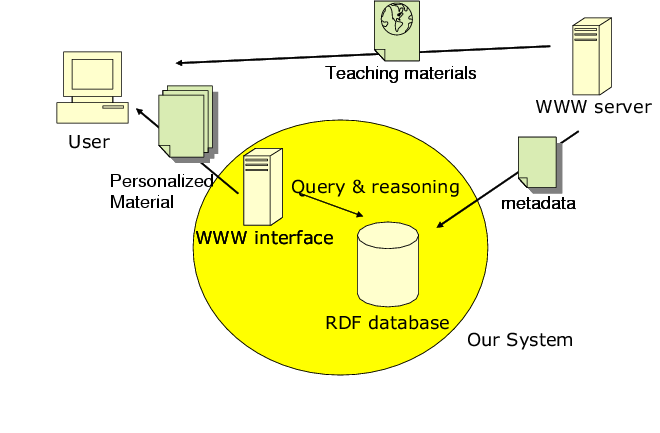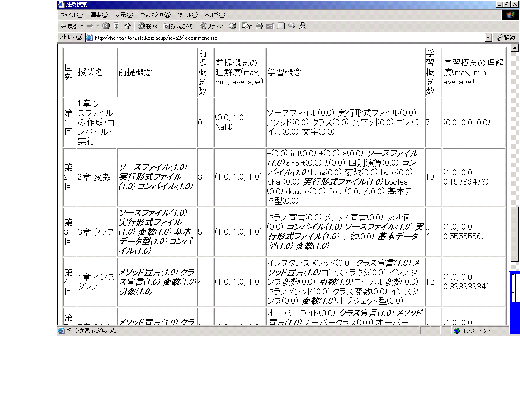
Figure 1. System Overview
In this paper, we present a system which personalizes teaching materials for Web Based Training (WBT). Our system can generate personalized teaching materials from user's knowledge, user's preference and metadata of teaching materials. Each teaching material has two kind of metadata: prerequisite knowledge and knowledge which it teaches. Those metadata and user profiles are expressed using Resource Description Framework (RDF).
Personalization, Web Based Training, RDF
Recently, e-learning is becoming very popular. The main stream of e-learning is ``Web Based Training (WBT)'' and many companies come into WBT business and make many WBT contents. Universities also put a lot of teaching materials on Web. When there are a huge number of teaching materials, it is very difficult for users to choose which materials are most suitable for them. It is not preferable that users have to learn ununderstandable materials. Users have to know prerequisite knowledge. It is also not preferable to learn materials which users already know. For example, if a user knows C programming language, he can skip quite a lot of parts when he wants to learn java programming language.
We often use search engines in order to find things on Web, but it is very difficult to seach most suitable teaching materials which we described above using the current seach engines. We would like to solve this problem using Semantic Web technology.
In order to express knowledge, we use a set of concepts. Each concept is represented by a keyword. We allow relations such as is-a and part-of among concepts, so the concepts have a graph structure.
Figure 1 shows the overview of our system. The system generates an ordered list of materials from user's knowledge and metadata of teaching materials. User's knowledge is provided as a user profile which is a set of concepts and degree of understanding of each concept. Each material has two metadata: a set of prerequisite concepts and a set of concepts which users can learn from it. The generated list does not contain materials which users already know. It is also properly ordered so that users can learn a concept before they need it as a prerequisite.

Figure 1. System Overview
We propose three strategies to select most suitable teaching materials: for beginners, middle level and specialist. Users can choose one of these algorithms depending on his preference.
Pi is the set of prerequisite concepts
for material i and Qi is
the set of concepts which material i teaches.
K is the set of
concepts which user knows and N is the set which he does not know.
S and T are the following sets:
S = {k ∈ N | ∃e ∈ K where r(e,k)}
T = {k ∈ N | ∃e ∈ K where u(e,k)}
where r(e,k) is the relation
which expresses e is a concept close
to k and u(e,k) is the relation
which expresses e is a more specific concept than k.
We now have a set of candidate materials, which satisfy the condition specified by the preferred strategy. Our system selects one of them according to a certain criterion (e.g. the number of new concepts the user can learn), and estimates the user's profile after learning the selected material with the assumption that the user will fully understand the concepts included in it.
User's profile is determined by doing a placement test. Each question of the test is associated with some concepts and correct or incorrect answer of the question changes the degree of understanding of those concepts.
We implement our system as a Web application. Figure 2 shows the implementation overview. It gathers metadata from servers which have teaching materials and stores them in its RDF database. When a user accesses the system, Web interface sends a query to the RDF database, generates the result according to selected algorithm and shows the result as a Web page. By clicking hyperlinks in the result, user can access the real teaching materials. Figure 3 shows an example of the generated result. Since we use RDF, we can combine the result with other systems.

Figure 2. Implemenation Overview

Figure 3. An Example Result
We have implemented the system and tried several examples in order to test that our system works properly. We will conduct actual experiments and evaluation. Followings are some of our future works: